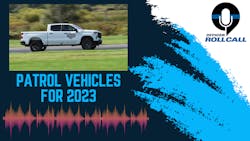On this episode of the Officer Roll Call Podcast, OFFICER Magazine Editor Paul Peluso and Officer Media Group Editorial Director Frank Borelli discuss the annual Michigan State Police Precision Driving Unit’s Vehicle Evaluations held this past fall and the trends observed for the 2023 model year.
“The Michigan State Police has been doing this for a long time,” says Borelli about the annual testing of law enforcement vehicles. “One of the biggest benefits is that there are so many small agencies that have no way of testing all of these vehicles; getting them all in, putting them through all of the riggers of the testing that the Michigan State Police does. So the reporting that the Michigan State Police, the feedback on all of the vehicles and what’s coming out new for next year, it’s a huge benefit for the agencies that simply can’t test their own and it serves a lot of information that doesn’t get disseminated.
“The thoroughness of the information and testing and the detail of the reporting, that’s all benefit to the law enforcement agencies that can’t do it on their own, and to the ones that can, and then they use this either as verification or they have a secondary set of data to go to their chief or whomever and say ‘We need to buy these.’ ”
While a lot of the 2023 class is comprised of holdovers from the previous model year, General Motors added two models of the Chevrolet Silverado for the first time, joining the Ford F-150 Police Responder as the only pickup trucks tested by the agency. This addition to the testing field follows the trend of the larger, more spacious vehicles being offered to law enforcement agencies. Just five years ago, the Chevrolet Caprice, Ford Police Interceptor Sedan, Ford SSP Sedan and Dodge Charger Pursuit were all included in the annual testing. Today, the Charger Pursuit remains the only remaining sedan as both GM and Ford have switched their focus to SUVs and pickup trucks.
“I have a fondness for the Dodge Charger and I look forward to them hopefully keeping it around as the only sedan, but they no longer really have competition from a police package Impala, Malibu, Taurus or any of that,” says Borelli. “Pickup trucks and SUVs really seem to be the wave of the future, which is radically different from where it was 40 years ago and probably unexpected if you were back then talking about what the future might hold.”
Borelli shares his memories of the iconic police package sedans that used to patrol roadways throughout the country. “My first was a Dodge Diplomat, way back in the 80s,” he says. “You had the Nova, the Malibu, the Impala, the Caprice and then you still had your specialty vehicles. The guys who were in the state police doing traffic enforcement in the big states with long, flat roads like Arizona, they would have Trans Ams or Corvettes; they were using them for pursuit. At some point—I remember in the 80s we had K-9 units using SUVs and pickup trucks and then the SUVs found their way into SWAT teams. In my local area, they started pricing it out comparing SUVs to pickup trucks with caps on them and all of the appropriate equipment and they found out that the pickup trucks were less costly. When you look at storage space and transport space—you still needed the backseat—it just became more cost efficient to purchase a pickup truck and upfit it than it did to buy the SUV.”
During the conversation, Borelli also shares the benefits of being able to patrol from a higher vantage point in an SUV or pickup truck versus a sedan. “When you are a little bit higher up and you are passing a vehicle and you look down into the vehicle, obviously you can observe things that you can’t looking down into the window. Being able to see farther ahead down the highway allows you a better response time and more time to react to unexpected circumstances in front of you, or to see simply where you are going for an accident or a disabled vehicle. That little bit of increase in height does play a critical role in observation and simple visibility.”
With those benefits, he cautions that there are some drawbacks. “The downside is that with pursuits, the higher you are, the higher your center of gravity is and the less maneuverability you have. It is a trade-off, but since we have so few pursuits going on these days and law enforcement in general is moving away from vehicle pursuits unless it is for a specific purpose and in a pursuit vehicle, it’s safer to have a helicopter up above, honestly. I think the trade-off is well worth it, there is a benefit to that increased height.”
Another trend that was evident during the testing was the presence of an all-electric law enforcement vehicle. As with 2021’s tests, the Ford Mach-E was submitted and performed similarly to the one sent in that year when it came to acceleration, speed and braking statistics. This comes as both Ford and GM announced future production of larger patrol EVs. The F-150 Lightning Pro SSV and the Chevrolet Blazer EV PPV weren’t submitted for testing this year, but could be added to the lineup in the near future.
While Borelli views the trend of all-electric vehicles as a positive development, he expressed some skepticism when it comes to the introduction of such vehicles as daily-use patrol vehicles. “I see electric vehicles in law enforcement really being confined to specialty assignments,” he says. “Not to downplay those roles, but like true inner city patrol or parking enforcement or code enforcement or something like that. When it comes to highway patrol, I’m not sure in the long run that the electric vehicles are going to be able to hold up with the gasoline-powered vehicles.”
The Officer Media Group editorial director continued: “I think that we’re going to find charge times become prohibitive and honestly, politics drives so much policy in law enforcement and there is still a huge political debate going on around the efficacy of electric vehicles and whether they are good or bad and how they get their power and whether or not they are doing any good for the enforcement. Law enforcement doesn’t need to be in that debate, but we’re going to be a victim of that debate. How electric vehicles end up in law enforcement is going to be a combination of politics and cost. Ultimately, I think they are going to stay in some limited roles, but unless you can get an electric vehicle that can go an 8 or 10 hour shift and recharged in an hour or two or less, you have to have more of those vehicles than you do fossil vehicles where you can have pool cars that go from first shift and they fill the tank and drop it off to second shift and so on. If those are electric vehicles, and you have to have an hour or two or three or more overlap for charge time, then you have to have more vehicles. It will be interesting to see how it turns out.”
Borelli closed the conversation with a look back at the evolution of law enforcement vehicles that he has observed during his career. “In the military it was just a utility vehicle. We had pickup trucks, we had Dodge Darts—the old boxy ones that were superior ugly vehicles in my opinion. Then I got to the civilian law enforcement world and had the Dodge Diplomat, Chevy Caprices and we moved through Impalas. The Ford Crown Victoria was truly a classic law enforcement patrol vehicle. It was shame when they were discontinued, the full sized Crown Vic, but I think we’re going to see an effort across the board for vehicles to be more environmentally friendly, whether that means better fuel efficiency or electric vehicles. We’re going to see more and more stuff carried in then, so we’re going to have to stay with SUVs and pickup trucks and the amount of equipment officers have to carry on their person isn’t going down anytime soon.
“I think we are finding a maximum limit of efficiency versus comfort and convenience, but I think the 5 to 10 years are going to hold some really interesting developments and I look forward to seeing what they bring.”
If you have any questions, suggestions or want to write us note about this episode of the Officer Roll Call Podcast, email [email protected].



